John Molleson's Ancestors |
Click on a name for info, click on an arrow to follow that branch, click Home to go to the main page, or click for an Alphabetic List of all Names. |
|
|
Forward Arrow is disabled at this time. Note: Before 1752 the year began on March 25th. Dates between January 1st and March 24th were at the end of the year, not the beginning. |
| ~< Back to Chart >~ |
Gilbert Molleson was baptized on November 4, 1613, at St Nicholas Church in Aberdeen, Aberdeenshire, Scotland. He was one of seven children and the eldest son born to parents Thomas Mollesone and Bessie Leask. He became a successful merchant, burgess, baillie and a magistrate of Aberdeen.
Gilbert married Margaret Smyth on February 11, 1645, in the same Saint Nicholas Church he was baptized in. They had at least thirteen children, all born in Aberdeen and baptized at St Nicholas church on the dates shown – Thomas on November 18, 1645, probably died as a child; Gilbert on April 7, 1646 who died before age 2; another Gilbert on November 7, 1648, who died before age 10; a daughter Christian, who was born about 1649, and married Robert Barclay in late 1669; Robert on January 10, 1650/51, probably died as a child; Bessie on February 26, 1651/52, married Thomas Hay; Margaret on August 26, 1653, married David Falconar on March 7, 1672; Jeane on March 13, 1656/57, married Joshua Middleton in the Fall of 1697; Barbara on February 14, 1658/59, married Thomas Cole on March 7, 1705/06; another Gilbert on August 14, 1659, who married a woman named Margery and after her death, married Sarah Curtis on August 25, 1715; twins Elspet and ancestor John on December 10, 1661; and Marjorie on March 19, 1664. Some researchers believe there was another son Alexander, born about 1649/50, but no records can be found to confirm this. He could be a twin to Christian, as her christening records cannot be found either, but there is other documentation to confirm her as their child. What is truly amazing is that Gilbert remained a ballie and magistrate of Aberdeen in the 1660’s and 1670’s, which was the period of persecution of the Quakers in that town. Although his children were all baptized in the Episcopal church, they were all raised as Quakers. In 1670, shortly after his wife died, he held the first Quaker wedding in Aberdeen in his house for his eldest daughter Christian who married the famous Quaker Robert Barclay (who later was incarcerated for five months while his father-in-law was a magistrate). Although historians have wondered what Gilbert’s role in the persecution of the Quakers was – did he secretly fight against it and helped to lessen it; did he take part in it; or did he just stand by and let it happen – Gilbert certainly loved his family. Gilbert Molleson died on April 21, 1689, and is buried in the St. Nicholas Churchyard with his wife. His section of the flat ground tombstone reads “Here rests in the Lord Gilbert Molyson late Baillie of Aberdeen who departed this life Ap 1689 and of age 76 years.” (Mouse over image below of the grave slab in Margaret's bio.) |
| ~<^>~ |
Margaret Smyth was born about 1627, probably in Aberdeen, Aberdeenshire, Scotland, to unknown parents. Not much is known about her early life except what has been written in many books about her conversion to Quakerism and her death. The accounts state that “in her youth she was an inquirer after the best people, and joined herself in worship with the most strict and refined profession then in that city” and “she had hungered and thirsted after righteousness.” At about 18 years old, she married the 32-year-old Gilbert Molleson on February 11, 1645 in the Saint Nicholas Church in Aberdeen and they had eleven children together, but only nine reached adulthood. By the end of 1662, the Quakers came to Aberdeen and Margaret became one of the first Quakers in Northern Scotland. Her husband did not become a Quaker, but they raised their children as Quakers. In Volume 4 of the book Piety Promoted, it states “. . . although her love to her husband, and cares of her many children, were great, yet her greatest delight and care was, to draw nearer and nearer to the true and living God, the chiefest beloved of her travailing soul.” The books go on to talk about the months preceding her death, how her knees were worn from kneeling in prayer, and how she would meditate in prayer during the night. On the morning of December 16, 1669, she became sicker than she had been, and her doctor told her not to fear, that she will not die. She responded to him “Fear, I have no cause; but thou wilt see thou art mistaken.” As her condition worsened, her friends and family gathered around her bed and prayed for her healing. She said to them “My advocate is with the Father, and my peace is made: I am feeding at a table none of you perceiveth.” She then looked at her 10 year old son Gilbert and told him “Truth is precious; cleave to it.” Her last words were “Now interruption is to cease, and my eternal joy is already begun!” It is said that Margaret died in Aberdeen on the 16th day of the 10th month of 1669 at about 42 years old. But in volume VII of the January 1895 issue of Scottish Notes & Queries, the text of the Diary of John Row, Principal of King's College, reads, “Dec. 14 '69. died Margt Smith, Quaker, spouse to Gilb, Molleson bailie of Abd ; a few houres after miscarying ; leaveing 2 sons & 7 daughters.” It is possible that she died on the 14th and was buried on the 16th. She died while having a miscarriage and all of her daughters and her two youngest sons, Gilbert and ancestor John outlived her. She is buried in the St. Nicholas Churchyard with her husband. Her section of the flat ground tombstone (mouse over image below) reads: 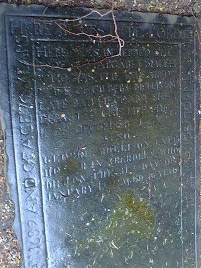 “Here was interred the The inscription continues naming a George Mollison who died in 1834, whose relationship to the ancestors is not known. The inscription continues with: “The memory of the Just In Volume II Number II of the April 1889 Scottish Notes & Queries, is an article written by Alex M. Munro entitled Epitaphs & Inscriptions in St Nicholas Church and Churchyard. Besides giving us the exact wording on the stone, he goes on to say that built into the wall above the stone is a rough slab of freestone with the initials G.M. and M.S. carved into it. (Today, almost 125 years later, the old stone probably isn’t readable anymore.) From how the inscription reads and the presence of this older stone, it seems that the inscribed flat ground stone was laid much later after Gilbert and Margaret’s deaths. |
| ~< Back to Chart >~ |
Thomas Mollisone married Bessie Leask in February of 1605 at the Saint Nicholas Church in Aberdeen and they had at least seven children, all baptized in St. Nicholas’ on the dates shown – Barbra on April 29, 1606; Elspett on March 15, 1608; two unnamed daughters on June 2, 1610 and in August 1611, it is not known if these girls survived to adulthood; ancestor Gilbert; Thomas on December 10, 1616; and John on March 9, 1620. Thomas was the Town Clerk of Aberdeen for many years, passing the job to his son Thomas after he retired. This makes determining when he left the job or even when he died very difficult to figure out. It is believed Thomas Molleson died in 1629, but no records have been found to confirm this. He was dead by November 30, 1631, when his wife was listed as a widow in the court records. He was probably buried in St. Nicholas’ churchyard. |
| ~<^>~ |
Bessie Leask was born about 1560 in Auchmad, Scotland, daughter of Thomas or Walter Leask and Barbara Mowat. Her mother was married to both a Thomas and a Walter Leask, so which one is her father is unclear. Some researchers believe Thomas died without issue, and Walter is Bessie’s father. Bessie married Thomas Molleson in February of 1605 at the Saint Nicholas Church in Aberdeen and they had at least seven children (see Thomas above for details). In Issue 31, Volume 28 of the Records of the Sheriff Court of Aberdeenshire, for November 30, 1631 there is an entry under the heading of Decree Books that reads: “Bessie Leask, widow of Mr. Thomas Molyson, an assignee of the late Barbara Mowatt, v. Wm Leask, younger, of that Ilk. Action awakened.” It seems to be saying that Bessie was taking legal action against her brother William in a matter having to do with the estate of her mother. In Volume 2 of the Aberdeen Council Letters: 1634-1644, “Bessie Leask, widow of Mr. Thomas Mollysone, clerk” is recorded in the Council Register on a list of widows who are each “to receive 20 merks per year.” It is not known when and where Bessie Leask Molleson died, but she was probably buried in the St Nicholas churchyard with her husband. |
| ~< Back to Chart >~ |
Gilbert Malisoun was born about 1500 in Aberdeen, Aberdeenshire, Scotland, the only known child of Alexander Malisoun and Margaret Kintor. The New Spalding Club translated records entitled Cartularium ecclesiae Sancti Nicholai Aberdonensis, in the book Publications: St. Nicholas Church, Aberdeen, Scotland. In it, under the heading of Foundation of Alexander and Gilbert Malysone 8th September 1519, is a paragraph describing a gift that Gilbert gave to the church for a special mass to be said every Friday “ . . . at the Altar of S. John the Evangelist, with intention for, and in behalf of, the soul of a late prudent burgess, Alexander Malysone, and the soul of Margaret Kintor, his wife, . . . Gilbert Malysone, his son and heir, paid to us in pure alms, for the support of us and our successors, the sum of twenty-four pounds, . . .” (See the full text under his father’s bio.) It is believed Gilbert married Anna Chalmer, who was born about 1514 in Alvah parish, Muiryhill, Banffshire, Scotland, daughter of Alexander Chalmer of Murthill and Elizabeth Douglas. Gilbert is known to have at least three sons, all born in Aberdeen – Alexander, his heir born in February 1536/37; ancestor Thomas; and Andro. It is not certain that Anna is the mother of these children, but if she is, the line goes much further back in time. Gilbert Malisoun was a merchant of Aberdeen and became one of its Burgesses probably on August 3, 1528, when he is first mentioned in Volume 1 of the Extracts from the Council Register of the Burgh of Aberdeen. He is repeatedly called an honourable man in both books. He was entrusted with holding collecting and distributing funds-on February 11, 1540, the council charged him as maister of the brig wark, and gave him funds to settle a dispute between some locals and the master of an Egyptian ship; the care of church silver-on march 18, 1561, it states he had the care of the church silver since January of 1559; and the creation and witnessing of many decrees and deeds. He remained in this position his entire life, as the last mention of him is on September 2, 1562, when his son Alexander replaces him on the Council. Thus it is assumed that Gilbert died prior to this date or shortly afterwards. |
| ~<^>~ |
Thomas Leask was born about 1534 in the area of Auchmad and Belschamphie in Aberdeenshire, Scotland, the eldest son of eight known children of William Leask of that Ilk. It is not certain that he is an ancestor (more on this in his wife’s bio), but the ancestry seems to certainly follow his line. There is more than one theory as to the origin of the name Leask. In her book, The Leasks: Historical Notes on the Aberdeenshire, Orkney and Shetland Families, Anne Leask tells us that the name Leask is of Norse or Danish origin and means ‘a stirring fellow.’ “The Leask family traditionally appears to have come from the northeast corner of Aberdeen. Members of the family held lands in Aberdeen, as well as the Orkney and Shetland Islands, and were part of the Clan Leask.” Another theory states the name came from the Anglo-Saxon word lisse, which means happy. A third theory is that the name comes from Liscus, which was the name of the chief of a tribe called the Haedui. The Haedui were a tribe of Gauls as described by Julius Caesar in his Gallic Wars. Yet another theory states that it comes from the Gaelic, Lasgair, meaning active or brave. Another theory is that it comes from a family called de Lesque of the Castle of Boulogne, once in the possession of Charlemagne and one of the greatest castles in France. William de Laskereske's signature appears on the Ragman Roll of 1296. But the simpliest theory is that the Leask name originated from the Aberdeenshire Lands of Leask, Leskgoroune as in those early times, families were often known by the name of the place they came from. For more on this family name, visit the Clan Leask Society website. In the Aberdeen Sheriff Records it is documented that Thomas lived in Auchmaude (or Auchmad) in 1575 and 1576. That would be after his marriage to Barbara Mowat and the births of her known children. Also in these records there is a Breach of Arrestment, the entry occurring on 9th October, 1584, which was against William Lesk of that Ilk and Thomas Lesk his eldest sone. It would seem his father was grooming him to become the 8th Chief of Clan Leask, but Thomas died before his father. It is believed he died shortly prior to August 7, 1595 (see his wife’s bio for more). |
| ~< Back to Chart >~ |
Barbara Mowat’s birthdate, place and parentage are unknown. It is believed she was born about 1534 in Balquholly, Aberdeen, Scotland. Some researchers say her parents were Patrick Mowat who was born about 1514 in Balquholly and Margaret Cheyne who was born about 1514 in Esselmont, Scotland. Others say she was the daughter of Barbara Sinclair, Lady Raffenshall who was born about 1518 and Bartholomew Bertil Mowat, of Swinzie, who was born in 1504-both born in Scotland, but lived in Norway for a time. In The Register of the Great Seal of Scotland, which seems to be written in Latin and contains the statutes and laws of Scotland for the period of 1593 and 1608, Barbara’s name is mentioned as being of the Mowat family of Busbie, who was married to Thomas, the elder son of William Leask. What most researchers agree on is that she was an aunt to Anders Mowatt of Hugoland and the family descends from James de Mohaut. It is believed the Mowats or Mouats came from Norway to the Orkney Islands and then to mainland Scotland and held Loscragie and then Balquholly. The fact that Barbara Mowat was married to Thomas Leask, son of William Leask of that Ilk, is documented in The Register of the Great Seal of Scotland under the date of August 7, 1595. Her name is mentioned after a long and confusing translation of the paragraph about Thomas’ living father William and his son William the younger. It seems to be saying that after William the father’s death, revenue is to go to the elder son L. The very next sentence states that Barbara has paid revenue or rent as the wife of said Thomas. The next and last sentence relates to the contract of William Jr’s marriage. One could interpret this as a summary of the changes to William Sr’s will because his eldest son Thomas has died. He is turning over the prospect of the inheritance from the now deceased Thomas to William, his younger brother, who can now get married because of this change. This supports the fact that Thomas had recently died. Charles Mosley, the editor of Burke’s Peerage, Baronetage & Knightage, 107th Edition, agrees with this death date as he states that Thomas died in 1595. Unfortunately, he states that Thomas died without issue and Barbara married Walter Leask of that Ilk, son of Alexander Leask in 1596 (Thomas’ first cousin who became the 8th Chief of Clan Leask) and Walter was the father of Barbara’s children. There are no marriage, birth, and death records easily available to confirm this, so it is uncertain as to which man fathered which child. Given these dates it seems quite impossible that Walter can be the father of ancestor Bessie, unless he was her first husband and Thomas was her second husband. Walter could have been the second husband, but he would have been the one who died without issue, not Thomas. Another scenario is that Thomas was a second husband and an unnamed man was Bessie’s father! Lastly, the option that there were two Barbara Mowats that married Leask men and these two Barbaras are getting confused with each other is certainly possible. Barbara Mowat Leask had at least three, maybe four, children all born in Aberdeen, we believe with husband Thomas – ancestor Bessie is thought to be the eldest; William about 1565; Alexander about 1570 and possibly James, whose birth year is unknown. Barbara Mowat’s name is mention several times in The Records of the Sheriff Court of Aberdeenshire. On February 22, 1603 a Criminal Indictment and Trial entry states “Thow art Indytit for the thifteous steilling fra Barbara Mowat relict of Umquhill Wa Leask of that Ilk . . .”. It isn’t clear if she was the one arrested or if someone else was stealing from her. Relict was a term used for widow at that time, so Walter has died by 1603. On November 18, 1605 a Judicial Enactments entry reads, “Loosings of Arrestments. Barbara Mowat, Lady Leisk, Wm. Leisk of that Ilk and George Gordoun of Bogbray v. Alexr. Forest in the Newtoun of Colliestoun. Claim for the rent and arrears of rent of Bogbray. Cautioner Andrew Reid of Colliestoun.” The William mentioned is probably her son or brother-in-law. The last entry is after her death, on November 30, 1631 under the heading of Decree Books that reads: “Bessie Leask, widow of Mr. Thomas Molyson, an assignee of the late Barbara Mowatt, v. Wm Leask, younger, of that Ilk. Action awakened.” This seems to mean her son William, and her daughter, ancestor Bessie, went before the court concerning her estate. Some researchers say she died in 1624 and is buried in St. Nicholas Churchyard in Aberdeen. All we know for sure is that she died between 1605 and 1631. |
| ~< Back to Chart >~ |
Alexander Malison was born about 1470 in Aberdeen, Aberseenshire, Scotland, to John Malisoun and an unnamed wife. Alexander became a burgess of Aberdeen and married Margaret Kintor. They had only one known child, ancestor Gilbert, although the church records seem to indicate there were more children. In the book Publications: St. Nicholas Church, Aberdeen, Scotland, Cartularium ecclesiae Sancti Nicholai Aberdonensis, the following church record is recorded under section LXXXII. Foundation of Alexander and Gilbert Malysone. 8th September, 1519. (Translation.): “KNOW all by these presents that we, the curate and chaplains for the time being of the college or choir of S. Nicholas of Aberdeen, have obliged ourselves, according to the tenor hereof, and do oblige ourselves and our successors for ever, to celebrate, to the laud and glory of Almighty God, of His blessed Mother Mary, and of the whole court of heaven, every Friday one Mass of the Five Wounds of Our Lord Jesus Christ at the Altar of S. John the Evangelist, with intention for, and in behalf of, the soul of a late prudent burgess, Alexander Malysone, and the soul of Margaret Kintor, his wife, and the souls of their parents, children and kinsfolk, in consideration that the same Alexander Malysone gave to us, and Gilbert Malysone, his son and heir, paid to us in pure alms, for the support of us and our successors, the sum of twenty-four pounds, wholly for our use and the support of our successors, and for constructing, repairing and building our common dwellings, and particularly that tenement of ours lying in the Shiprow, between the land of Thomas Chawmer on the north, and the land of the heirs of the late Thomas Prat on the south, the king's highway on the east, and the Hill of S. Katherine the Virgin on the west. And, for the performance and inviolable observance hereof by us and our successors, we unanimously decern and have decreed this writ, confirmed by our signs-manual, and under hypothec of all the common goods of ourselves and our successors both present and future. Done in our chapter-house, with the unanimous consent of the brethren in chapter assembled, and called together for this end, on (the Feast of) the Nativity of the Blessed Virgin Mary, 8th September, 1519.” The church curate and rector of the grammar school, plus ten others, all titled with Sir, signed this record. From the text it seems that there were other children. It also seems the Margaret had died sometime before her husband’s death, which seems to be recent, sometime before September 8, 1519. They are both probably buried in the St. Nicholas Churchyard. Unfortunately nothing more is known about either of them, nor of Margaret’s parents. |
| ~<^>~ |
William Leask’s name is listed as William Leask of that Ilk in all the books and records. His birthdate is unknown, but some researchers say it was about 1508. He was the eldest of two known sons of William Leask of that Ilk, 6th Chief of the Leask Clan, thus William Jr became the 7th Chief of Clan Leask. The Clan Leask Genealogy website states “William Leask, 7th of Leask, on February 26, 1514/1515, as Willame Lesk, Burgess of Abirdene, grants a letter of manrent in favour of William Hay, Earl of Errol.” (This website states that the information is from volume 3 of the Illustrations of the Topography and Antiquities of the Shires of Aberdeen and Banff; volume 2 of Miscellany of the Spalding Club; and The Leasks of that Ilk and their Cadets.) It should be noted here, that this researcher has not found proof of this manrent in the online index of The National Archives of Scotland, but not every manrent was listed in this index in detail. The Clan Leask Society website tells us that “In 1456 a Bond of Manrent was signed by Unfra Leask of that Ilk, the 3rd Leask Chief, in favour of William Hay, Earl of Errol, Chief of the Clan Hay; this pledged the support of the Clan Leask in all times of trouble.” This Unfra is Humphrey, William’s Great Grandfather. So William’s manrent may have been a renewal or affirmation of the old one. (Manrent is a Scottish contract of military alignment between clans. The bond of manrent was an instrument in which a weaker clan pledged to serve, in return for protection, a stronger clan, in effect becoming a vassal that renders service to a superior. More simply it was a promise by one person to serve another and that he shall be friend to all his friends, and foe to all his foes.)
His name appears frequently in Volume I of the Records of the Sheriff Court of Aberdeenshire, edited by David Littlejohn. There are lawsuit records that he was involved in from January 12, 1558/9, which reads, “Appointed by Sheriff principal to try actions between Barbara Hay and James Gordoun of Creichie her husband against Wm. Lesk of that ilk, and sworn in by Andrew Fullertoun,” up until July 12, 1595 in which his son Henry was suing him, Henry Leisk v. Wm. Leisk, Elder. Unfortunately, the details of these records are written in what seems to be old Scottish and are barely readable. For example, the first paragraph of the October 9, 1584, Breach of Arrestment record reads, “The said day anent the summonds of walkining in the actioun and caus of Breking of Arestment perseuit be our Souerane Lord the Kyngs Ma/ Mr George Barclay his Procuratour Fischall my Lo/ Shref be vertew of his office and at the instance of Gilbert Reid of Collestoun aganis William Lesk of that Ilk and Thomas Lesk his eldest sone this day being assignit be ane walkining to pronunce Interloquitor in the said caus the Shref continewit the samyn in eodem statu to Andirsmes Evin nixtocum.” The editor sheds some light on what this means in another lawsuit brought against William by the same Barbara Hay and James Gordoun, dated May 3, 1559, “This appears to be another dispute, on this occasion about the pursuers' rights of property and commonly in the lands of Nether Lesk, which the defender had been invading in 1555-6 and 7.” So it seems that William was either a real rascal or had some very bad luck! In Madam Leask’s book The Leasks, she tells us that on September 2, 1574, William Lesk of that Ilk signed an oath of allegiance to the infant King James VI of Scotland, as one of the “Barons of the North and others.” William’s support was in opposition to Mary, Queen of Scots, the mother of King James VI, after the murder of Lord Darnley and her scandalous marriage to Bothwell. Madam Leask goes on to tell us that just twenty years later, in 1594, the Earl of Errol (who William had a manrent with) joined in the Earl of Huntley’s rebellion against King James VI, which resulted in the destruction of Slains Castle and the banishment of the Earl. Because William was not banished and kept his land, it seems he did not comply with the manrent, but honored his oath of allegiance to the King. Most researchers report that William Leask of that Ilk (7th Chief) died on January 29, 1597. After his death, because his eldest son died before him, the title of 7th Chief of Clan Leask went to his brother Alexander, the father of Walter who became the 8th Chief and married the widow of ancestor Thomas Leask, Barbara Mowat. |
| ~< Back to Chart >~ |
John Malisoun Jr was born about 1444 in Castle Street, Aberdeen, Scotland, to John Malisoun Sr. Not much is known about him or his father. John Jr. married and had at least one child, ancestor Alexander. John Jr. died after 1497 in Aberdeen. There are five records in the online index of the National Archives of Scotland that mention his name as a witness in various actions. It is not certain that any one record pertains to this ancestor, but they all could. The first dated 15/5/1471, lists a Mr. John Malisoun, vicar of Cranstoune and Archibald Huntare. The second and third records are dated 6 Apr 1472, for the same action and both list a Mr. John Malisone [Malison]. The fourth is dated 19/3/1473, lists a Mr John Maleson, vicar of Stobo. The last is dated 27 Nov 1475, lists him first as a witness with others as “Master John Maleson, and Sirs Patrick Layng and David Lichton, vicars of Stobo, Wemet and Logidorus.”This record seems very interesting as the record title reads as follows: “Letters and act of dispensation by John, bishop of Glasgow on the mandate of Philip, bishop of Porto and penitentiary of Pope Sixtus IV (dated 3rd June in the 4th year of the pontificate of the said Pope [1475]) dispensing with the impediment to the marriage of John Swynton and Catherine Laudre who were related to each other in the fourth degree of consanguinity, declaring their issue to be legitimate. Done in Edinburgh.” His father, John Malisoun Sr. was born about 1418 in Netherkirkgate, Aberdeen, Scotland. There is a record of a deposition in the online index of the National Archives of Scotland dated 6 Oct 1447 that has a John Malysoun [Malison] listed as a witness. Unfortunately, not much else is known about him except that he died after 1450 in Aberdeen. |
| ~<^>~ |
William Leask’s birth year is unknown, but some researchers say it was about 1482 in Auchmad and Belschamphie, Aberdeenshire, Scotland. He was the second of three known sons of William Leask, 5th Chief of Clan Leask. On the Clan Leask Genealogy website it states that Alexander Leask MS, in his book The Leasks of that Ilk and their Cadets reports that in volume 1 of the New Spalding Club Miscellany, it states “William Laysk, (second son of Wlliam Leask the fifth Clan Chief) is admitted a burgess of Aberdeen, co of Aberdeen, in 1505/06.” In 1513, William’s father and older brother died during the Anglo-Scottish Wars at the Battle of Flodden, thus he became the 6th Clan Leask Chief. We don’t know who, where and when William the 6th Chief married, but his two known sons were Alexander and ancestor William. It is believed that William Leask of that Ilk, 6th Chief of Clan Leask died about 1551. |
| ~<^>~ |
William Leask, 5th Chief of Clan Leask, birthdate is undocumented, but many researchers believe he was born about 1454 in Auchmad and Belschamphie, Aberdeenshire, Scotland, the son of Thomas Leask of that Ilk, believed to be the 4th Chief of the clan. The Clan Leask Genealogy website under the heading of Known and Documented Historical Evidence of Clan Leask states “Willielmo Laisk de eodem (William of that Ilk) is designated baillie (ballivo meo) of Gilbert Hay of Carmuk (Son of Sir Gilbert Hay of Dronlaw ak), in a precept of sasine in favor of Walter Hay, son of Gilbert Hay of Caramuk, of his lands of Caramuk and Ardgeicht, in the parish of Ellon, co of Aberdeen, dated at Ellon August 4, 1484. . . . William is the fifth Clan Chief.” The site lists several sources for this statement. This site list other reports of William which are also found in The National Archives of Scotland online index such as William of Laysk is a witness to a letter of manrent dated at the Chanonry of Ross on January 14, 1488/89; “Willelmo Lesk de eodem (William Leask) was witness to the precept of sasine, dated October 9, 1498 . . . in the barony of Slains, co Aberdeen; Willelmo Laysk de eodem, he is witness to a contract dated February 22, 1498/99” regarding a marriage arrangement; “As Willelmo Leisk de eodem, William Leask, 5th of Leask, appears in an instrument of sasine, dated in August 1504 . . .;” and “As Willelmum Laysk de eodem, William Leask is a member of an inquest, held at the court of Alexander Bannerman of Waterton, sheriff-depute of Aberdeen, at Aberdeen on February 17, 1509/10 . . .” We don’t know who, where and when William the 5th Chief married, but his known sons were – Alexander, the eldest and heir; ancestor William; and the youngest son, Thomas. The Clan Leask website states “In 1513, the Line of Leask Chiefs suffered a double disaster when both William Lask of that Ilk, 5th son, and his son, Alexander Lask of that Ilk, Younger, were both killed at the Battle of Flodden. The latter’s younger brother, William Lask, Burgess of Aberdeen, then became the 6th Leask Chief.” The Leask genealogy website gives us more detail on the battle against the English: “On September 9, 1513 the Leask Clan Chief (William Lask and his son (Alexander Lask) were killed at Flodden Field with their feudal superior William Hay, Earl of Errol and King James IV. The Earl of Errol fought on King James IV left with the Earls of Crawford and Montrose, between the borders division led by the Earls of Huntly and Home on the extreme left and King James IV who fought in the center.” The sources listed are the Electric Scotland and the Clan Leask websites as well as Scotland, The Story of a Nation, by Magnus Magnusson.
Battle of Flodden Today the battlefield is open free to the public in what is called the Flodden 1513 Ecomuseum or a “museum without walls - a collection of sites that capture the essence of the Battle of Flodden - arguably the most significant battle in UK history.” |
| ~< Back to Chart >~ |
Arms, Crests, Mottos, and TartansThe images on the chart were created from information and images from several books and websites as detailed below. The family crest is situated on the left, their shield or coat of arms is the middle and their motto is printed on the right in each image. The book, Fairbairn's Crests of the Leading Families in Great Britain and Ireland and their Kindred in Other Lands by James Fairbairn, Laurence Butters, and Joseph MacLaren includes a wonderful glossary, which was a great help in understanding what everything should look like. The Clan Leask Society website describes the Leask Arms and Crest as follows: “Our Arms (a shield) is sable (has a black outline) with a Fesse (a coloured central band across the shield) in argent (silver), between three mullets (five-pointed stars) in Chief (the top section of the shield); and as many Mascles (three lozenges) in Base (the bottom section of the shield) argent (silver). To the left is a digital representation of a crest badge suitable for use by a member of Clan Leask. The image was created by Celtus in January 2009 and is from Wikipedia, The Free Encyclopedia website. The notes on this image state: “In Scotland, the usage of heraldry is governed by legal restrictions, independent of the status of the depiction shown here. The crest and motto elements of the crest badge are always the heraldic property of an individual (the crest badges, used by most Scottish clan members, are usually the heraldic property of a clan's chief). Though a crest badge can be freely represented, in Scotland it cannot be appropriated or used in such a way as to create a confusion with or a prejudice to its owner.” The Leask coat of arms was re-recorded in 1672, in the newly established public register by the Rev. Alexander Leask of that Ilk, the 13th and last Leask Chief in Aberdeenshire. In 1698 the Leasks suffered terribly by investing heavily in the Darién scheme (which was later to become the route of the Panama Canal). The venture was a disaster with a vast amount of Scotland's wealth being lost which in some part led to the union of Scotland and England. Alexander was forced to give up his estates which were taken over by Robert Cumming, who moved into the Leask Mansion House about 1720. In 1963, a descendant managed to buy back a portion of the family lands and established the Leask Society with the support of other prominent Leasks. Today, Jonathan Leask, is the 23rd chief of Clan Leask. ~< Back to Chart >~
“Or, two crosses crosslet fitchée in chief and the attires of a stag affixed to the scalp gu. a chief chequy of the second and ar. The second crest is shown at right and the entry is for the Mollesons of “Aberdeen, 1672” and is described as follows: “As the last, within a bordure gu. The crest images are from the Fairbairn's book mentioned above, and its glossary helped in understanding the terms used in the entry as follows: or: gold, or yellow. Fairbairn's translates the motto as “Honest fame is the torch of the mind” and concurs with Burke's two entries and descriptions. Not knowing which crest would be correct, the choice of using the stag on the chart and not the blood dripping head, was purely esthetic! ~< Back to Chart >~ A Word About Tartans The Scots Connection website goes into great detail about the history of the Tartan. Here is only some of what they have to say: “OF SCOTLAND'S MANY ICONS, tartan is the most instantly recognisable. From the Highland Games circuits of North America and Europe to the fashion catwalks of Milan, its provenance is unmistakable. It is Scotland's very own international brand identity, and what makes this all the more remarkable is that no other country lays claim to it. From the earliest documentation, Scotland’s Highlanders were described as 'savages', referring to the bareness of their legs and general nakedness. However, it is patently evident that their everyday attire, or lack of it, was employed for practical use, hunting and fighting, not for show. It was not until the 16th century that the existence of patterned cloth in Scotland was confirmed by an entry in the Treasurer's Accounts of 1538 which tells us that King James V had ordered an outfit of 'Hieland tartane'.”
And it was in this way, almost unintentionally, that clan tartans evolved. The majority of Highlanders would have made use of the material that was available to them locally, but others, especially those who travelled around the country, might easily have seen it as a fashion statement in much the same way that someone today selects a tweed. Look no further than the group of portraits commissioned by Sir James Grant of Grant from the artist Richard Waitt between 1713 and 1726. Each clansman is shown wearing a different tartan.” The Leask tartan shown on right and the information about its registration is from the The Scottish Register of Tartans website. It is a wonderful site with much more information about tartans. The Leask tartan was “Recorded in Lyon Court Book 44 (15/09/1982). First woven by Scott Brothers of Wilton Mills, Hawick. For Madam Leask of Leask, Sheringham, Norfolk. Design could have been by Scott Brothers but Tartans Society was mentioned in other literature as was Madam Leask. Samples in Scottish Tartans Authority Dalgety Collection of modern colours and repro.” Unfortunately a tartan could not be found for the Molleson Family. |
| ~< Back to Chart >~ |
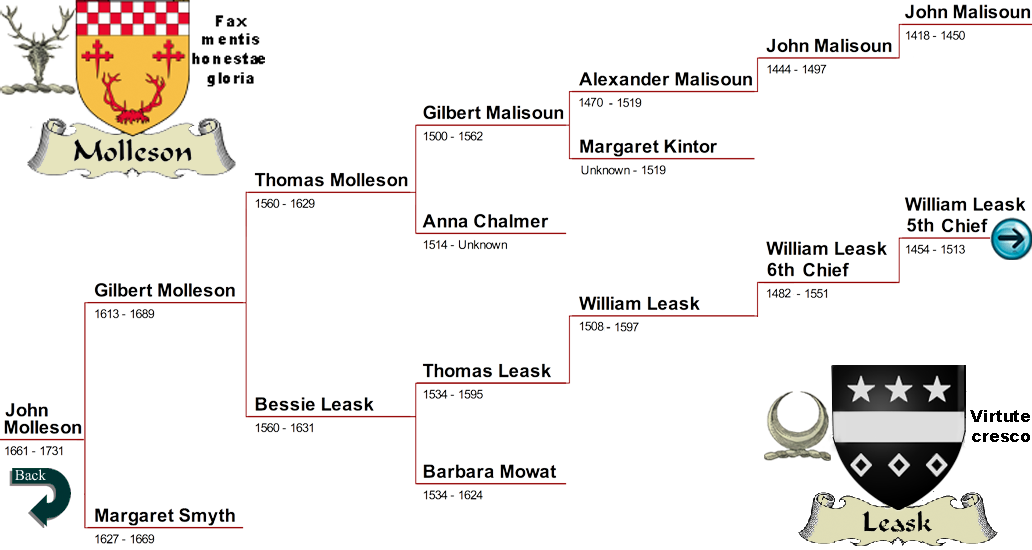
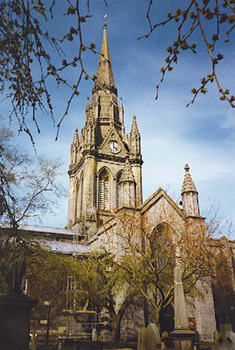 In 1644 to 1645 a Scottish civil war was fought between Scottish Royalists, supporters of Charles I, under James Graham, 1st Marquess of Montrose, and the Covenanters, who had controlled Scotland since 1639 and allied with the English Parliament. During this war Gilbert and several other citizens were detained for a short time by Covenanters “vnder guard as prisoners in the lauch counsel hous” of Aberdeen.
In 1644 to 1645 a Scottish civil war was fought between Scottish Royalists, supporters of Charles I, under James Graham, 1st Marquess of Montrose, and the Covenanters, who had controlled Scotland since 1639 and allied with the English Parliament. During this war Gilbert and several other citizens were detained for a short time by Covenanters “vnder guard as prisoners in the lauch counsel hous” of Aberdeen.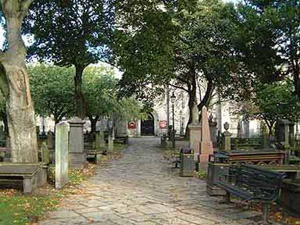 This is shown in a letter he wrote about his daughter Christian: “I must confess shee hez beine the most Deserving child I have to me, as severall tymez that precious servant And Sanct of the Lord, hir Deceast mother Did witness.” After his wife’s death he told people that “. . . he had lost a true Mary and a Martha, none knowing how great his loss was, and he could not but much lament it.” Gilbert, although strong in faith, never became a Quaker and some of his children left Scotland for the freedom of religion that the New World offered.
This is shown in a letter he wrote about his daughter Christian: “I must confess shee hez beine the most Deserving child I have to me, as severall tymez that precious servant And Sanct of the Lord, hir Deceast mother Did witness.” After his wife’s death he told people that “. . . he had lost a true Mary and a Martha, none knowing how great his loss was, and he could not but much lament it.” Gilbert, although strong in faith, never became a Quaker and some of his children left Scotland for the freedom of religion that the New World offered. Thomas Molleson was born about 1559 in Aberdeenshire, Scotland, to father Gilbert Malisoun and possible mother Anna Chalmer. It is not known what other brothers or sisters he may have had. This family was one of the leading merchant families in Aberdeen and the Molleson name, spelled many different ways, appears frequently in the town records. In Epitaphs & Inscriptions from Burial Grounds & Old Buildings in the North-East of Scotland, the authors write that Thomas was “of Lauchintully.” They go on to say that “Lauchintully is in the parish of Kemnay . . .” Kemnay is a town 16 miles west of Aberdeen.
Thomas Molleson was born about 1559 in Aberdeenshire, Scotland, to father Gilbert Malisoun and possible mother Anna Chalmer. It is not known what other brothers or sisters he may have had. This family was one of the leading merchant families in Aberdeen and the Molleson name, spelled many different ways, appears frequently in the town records. In Epitaphs & Inscriptions from Burial Grounds & Old Buildings in the North-East of Scotland, the authors write that Thomas was “of Lauchintully.” They go on to say that “Lauchintully is in the parish of Kemnay . . .” Kemnay is a town 16 miles west of Aberdeen.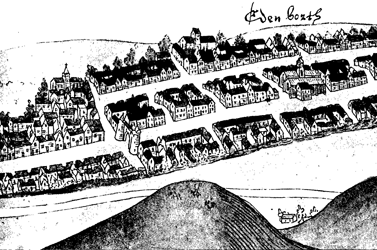 William married an unnamed woman and they had at least eight children, all born in Aberdeen, Aberdeenshire, Scotland – ancestor Thomas; William; John; Henry; Alexander; Patrick; Isobel; and Margaret.
William married an unnamed woman and they had at least eight children, all born in Aberdeen, Aberdeenshire, Scotland – ancestor Thomas; William; John; Henry; Alexander; Patrick; Isobel; and Margaret. 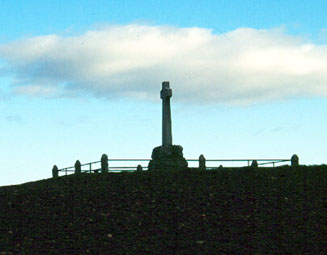 It's not known where William and his son were buried, but Robert Lindsay of Pitscottie tells us in volume 1 of The History and Chronicles of Scotland, that Branxton Church was the site of some burials from the battle of Flodden. It is also thought that the bodies of the Scottish nobles were retrieved from the battlefield and eventually repatriated, possibly by the nuns of Coldstream Priory. A monument of a granite cross (pictured) was erected in 1910 on the site by the Berwickshire Naturalists club to commemorate the battle. It is a tall tapering cross of polished stone, with raised roll-moulded edges, on a tapering base, of massive roughly-dressed stone. Set into the base is a bronze plaque inscribed:
It's not known where William and his son were buried, but Robert Lindsay of Pitscottie tells us in volume 1 of The History and Chronicles of Scotland, that Branxton Church was the site of some burials from the battle of Flodden. It is also thought that the bodies of the Scottish nobles were retrieved from the battlefield and eventually repatriated, possibly by the nuns of Coldstream Priory. A monument of a granite cross (pictured) was erected in 1910 on the site by the Berwickshire Naturalists club to commemorate the battle. It is a tall tapering cross of polished stone, with raised roll-moulded edges, on a tapering base, of massive roughly-dressed stone. Set into the base is a bronze plaque inscribed: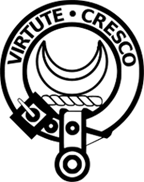 Above the shield is placed our Crest: a Helm befitting his degree with a Mantling sable (black) doubled argent (silver), and on a wreath of the liveries is set for Crest a crescent argent (silver), and in an Escoral over the same this motto 'VIRTUTE CRESCO'. Virtute Cresco is the ancient motto of the Leasks, meaning by virtue I grow.” The Fairbairn's Crests book states the motto more literally as “I increase by virtue” and simply lists the crest as a silver crescent.
Above the shield is placed our Crest: a Helm befitting his degree with a Mantling sable (black) doubled argent (silver), and on a wreath of the liveries is set for Crest a crescent argent (silver), and in an Escoral over the same this motto 'VIRTUTE CRESCO'. Virtute Cresco is the ancient motto of the Leasks, meaning by virtue I grow.” The Fairbairn's Crests book states the motto more literally as “I increase by virtue” and simply lists the crest as a silver crescent.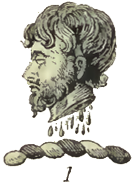 There are two entries for the Molleson family in Bernard Burke's book The General Armory of England, Scotland, Ireland, and Wales: Comprising a Registry of Armorial Bearings from the Earliest to the Present Time. The shields and mottos are the same, but the crests differ The first entry in the book is for the Mollesons from“Lachintilly, co. Aberdeen, 1672”, and is shown above in the chart. The description is as follows:
There are two entries for the Molleson family in Bernard Burke's book The General Armory of England, Scotland, Ireland, and Wales: Comprising a Registry of Armorial Bearings from the Earliest to the Present Time. The shields and mottos are the same, but the crests differ The first entry in the book is for the Mollesons from“Lachintilly, co. Aberdeen, 1672”, and is shown above in the chart. The description is as follows: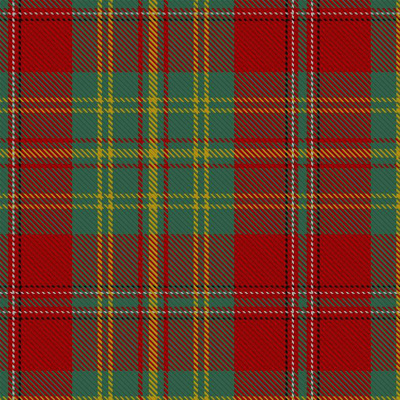 It is the ingenuity of the thread count that gives a tartan its individuality, not so much the colours employed, and what makes this especially remarkable is that such a mathematically ingenious formula was being manufactured in remote communities which were largely dismissed as primitive by the more populous regions of the South. It furthermore indicates that a sophisticated tribal society was emerging and it would soon be possible to identify districts from the colour patterns manufactured from the plant dyes available locally.
It is the ingenuity of the thread count that gives a tartan its individuality, not so much the colours employed, and what makes this especially remarkable is that such a mathematically ingenious formula was being manufactured in remote communities which were largely dismissed as primitive by the more populous regions of the South. It furthermore indicates that a sophisticated tribal society was emerging and it would soon be possible to identify districts from the colour patterns manufactured from the plant dyes available locally.